Egyptianizing Brooch
In 1894, Jacques de Morgan excavated several magnificent ancient pectorals from the tomb of Princess Mereret, daughter of Sesostris III, in Dahshur, Egypt. Soon after this discovery, this faithful replica was made. Unlike many Egyptianizing pieces, this example copies the details of the original without major errors or changes; only the size and material are slightly varied: silver and multicolored enamels replaced gold, carnelian, and faience. The brooch, in the form of a kiosk, gives the names of the pharaohs Sesostris III and Amenemhet III from the middle of the 12th Dynasty (19th century BC). Below the wings of a protective vulture, the pharaohs are depicted as humans slaying their enemies.
Provenance
Provenance (from the French provenir, 'to come from/forth') is the chronology of the ownership, custody, or location of a historical object. Learn more about provenance at the Walters.
Tiffany & Co., New York; Henry Walters, Baltimore, by purchase (?); Walters Art Museum, 1931, by bequest.
Exhibitions
| 2010 | Bedazzled: 5,000 Years of Jewelry. El Paso Museum of Art, El Paso. |
| 2006-2009 | Bedazzled: 5,000 Years of Jewelry from the Walters Art Museum. Frist Center for the Visual Arts, Nashville; The John and Mable Ringling Museum of Art, Sarasota; The Walters Art Museum, Baltimore. |
| 1990 | The Sphinx and the Lotus: The Egyptian Movement in American Decorative Arts, 1865-1935. Hudson River Museum of Westchester, Yonkers. |
| 1979-1980 | Jewelry - Ancient to Modern. The Walters Art Gallery, Baltimore. |
Geographies
USA, New York (Place of Origin)
Measurements
2 15/16 x 3 5/8 in. (7.46 x 9.21 cm)
Credit Line
Acquired by Henry Walters
Location in Museum
Not on view
Accession Number
In libraries, galleries, museums, and archives, an accession number is a unique identifier assigned to each object in the collection.
In libraries, galleries, museums, and archives, an accession number is a unique identifier assigned to each object in the collection.
57.1482



